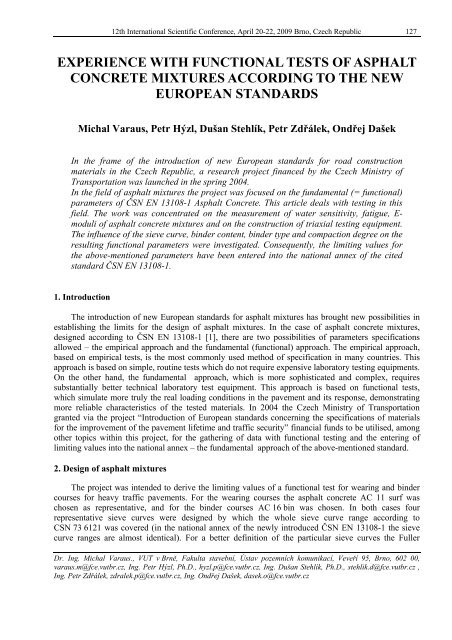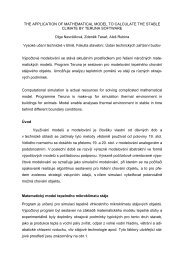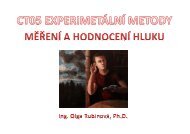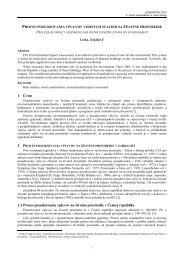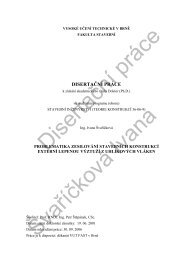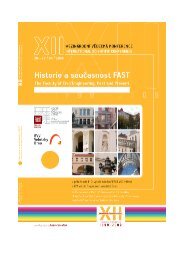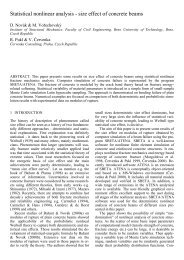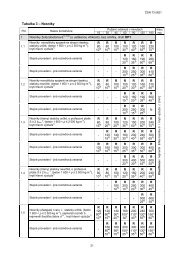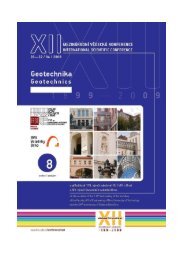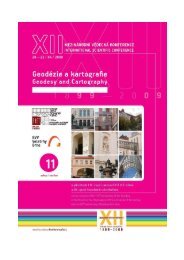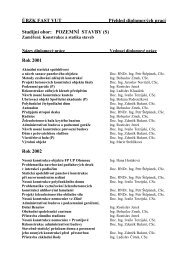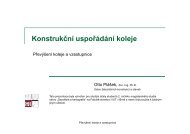Dopravnàstavby - Fakulta stavebnà- Vysoké uÄÂenàtechnické v Brně
Dopravnàstavby - Fakulta stavebnà- Vysoké uÄÂenàtechnické v Brně
Dopravnàstavby - Fakulta stavebnà- Vysoké uÄÂenàtechnické v Brně
Create successful ePaper yourself
Turn your PDF publications into a flip-book with our unique Google optimized e-Paper software.
12th International Scientific Conference, April 20-22, 2009 Brno, Czech Republic 127EXPERIENCE WITH FUNCTIONAL TESTS OF ASPHALTCONCRETE MIXTURES ACCORDING TO THE NEWEUROPEAN STANDARDSMichal Varaus, Petr Hýzl, Dušan Stehlík, Petr Zdřálek, Ondřej DašekIn the frame of the introduction of new European standards for road constructionmaterials in the Czech Republic, a research project financed by the Czech Ministry ofTransportation was launched in the spring 2004.In the field of asphalt mixtures the project was focused on the fundamental (= functional)parameters of ČSN EN 13108-1 Asphalt Concrete. This article deals with testing in thisfield. The work was concentrated on the measurement of water sensitivity, fatigue, E-moduli of asphalt concrete mixtures and on the construction of triaxial testing equipment.The influence of the sieve curve, binder content, binder type and compaction degree on theresulting functional parameters were investigated. Consequently, the limiting values forthe above-mentioned parameters have been entered into the national annex of the citedstandard ČSN EN 13108-1.1. IntroductionThe introduction of new European standards for asphalt mixtures has brought new possibilities inestablishing the limits for the design of asphalt mixtures. In the case of asphalt concrete mixtures,designed according to ČSN EN 13108-1 [1], there are two possibilities of parameters specificationsallowed – the empirical approach and the fundamental (functional) approach. The empirical approach,based on empirical tests, is the most commonly used method of specification in many countries. Thisapproach is based on simple, routine tests which do not require expensive laboratory testing equipments.On the other hand, the fundamental approach, which is more sophisticated and complex, requiressubstantially better technical laboratory test equipment. This approach is based on functional tests,which simulate more truly the real loading conditions in the pavement and its response, demonstratingmore reliable characteristics of the tested materials. In 2004 the Czech Ministry of Transportationgranted via the project “Introduction of European standards concerning the specifications of materialsfor the improvement of the pavement lifetime and traffic security” financial funds to be utilised, amongother topics within this project, for the gathering of data with functional testing and the entering oflimiting values into the national annex – the fundamental approach of the above-mentioned standard.2. Design of asphalt mixturesThe project was intended to derive the limiting values of a functional test for wearing and bindercourses for heavy traffic pavements. For the wearing courses the asphalt concrete AC 11 surf waschosen as representative, and for the binder courses AC 16 bin was chosen. In both cases fourrepresentative sieve curves were designed by which the whole sieve curve range according toCSN 73 6121 was covered (in the national annex of the newly introduced ČSN EN 13108-1 the sievecurve ranges are almost identical). For a better definition of the particular sieve curves the FullerDr. Ing. Michal Varaus., VUT v Brně, <strong>Fakulta</strong> stavební, Ústav pozemních komunikací, Veveří 95, Brno, 602 00,varaus.m@fce.vutbr.cz, Ing. Petr Hýzl, Ph.D., hyzl.p@fce.vutbr.cz, Ing. Dušan Stehlík, Ph.D., stehlik.d@fce.vutbr.cz ,Ing. Petr Zdřálek, zdralek.p@fce.vutbr.cz, Ing. Ondřej Dašek, dasek.o@fce.vutbr.cz


